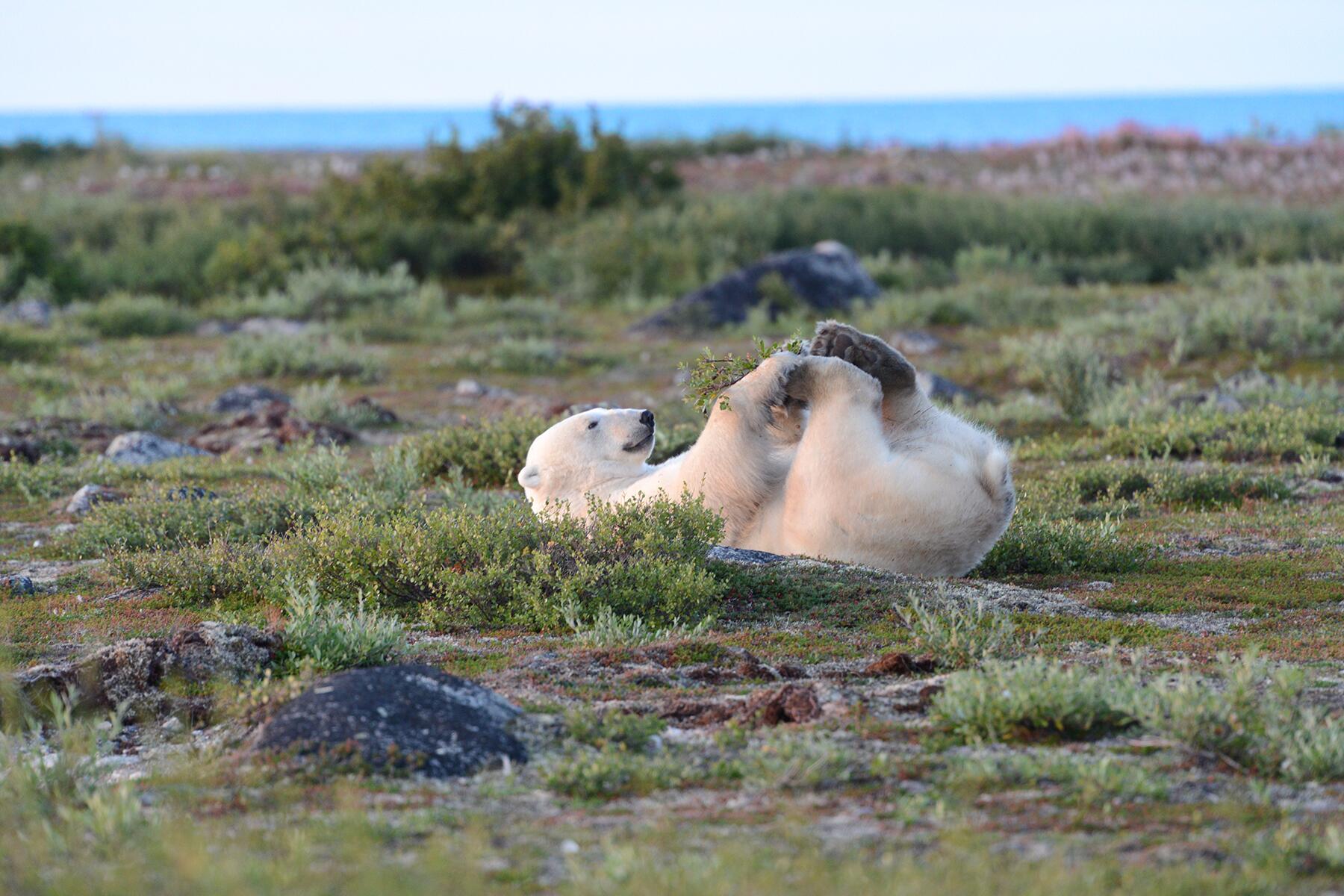From polar bears in Manitoba to whale sharks in Mexico, the North American continent offers its fair share of impressive wildlife viewing.
Let me first apologize to Rocky Mountain bighorn sheep and Wyoming’s stunning elk herd, as well as Minnesota’s moose and the country’s many mountain lions. Though large animals are extremely rare globally, we’re still fortunate in North America to see many species that live on or near our continent. In fact, consider this slideshow not so much a “Best Places to See Critters” list as a “Isn’t It Great to See Critters?” narrative that offers up a set of wildlife destinations and tour operators that encourage us to explore the wilderness and see these magnificent animals for ourselves.
Grizzlies
WHERE: Great Bear Lodge, Great Bear Rainforest
It may take you a while to get there. Still, the eight-bedroom Great Bear Lodge delivers such incredible brown bear viewing (and luxurious lodging) from the Smith Inlet on Kwakwaka’wakw First Nation territory you’ll never want to leave. Most visitors arrive in the fall to watch from the viewing platforms as bears pick off spawning salmon on the Nikite River. A spring visit yields extraordinary behavior, including mating and cub care. One foggy May morning, I watched a female sprint back and forth along the estuary shoreline for an hour until she finally located the male of her choice. Lodge co-owner, Tom Rivest, is also a bear whisperer extraordinaire with the erstwhile ursine tales and keen observations about individual bears to prove it.
Spirit Bears and Whales
WHERE: Desolation Sound
Former National Geographic Explorer-in-Residence and biologist Wade Davis calls Desolation Sound “The Serengeti of North America, only better given the marine mammals.” Maple Leaf Adventures conveys guests to all the best places along this protected British Columbia coast, including the Great Bear Rainforest, home to the fascinating Kermode bear (aka the Spirit Bear), a rare white subspecies of the American black bear. Orca pods also regularly rise beside guests sailing on the Swell (Tugboat), Cascadia (Catamaran), and Maple Leaf (Sailing Ship), that is, unless they’re lucky enough to be paddling a kayak at the time. Bubble-netting humpbacks are also common, as are grizzlies foraging on the coastal beaches. Desolation Sound is also home to the elusive sea wolf, a salmon-eating canid that can be seen foraging onshore by those with a keen eye.
Recommended Fodor’s Video
Orcas and Sea Lions
WHERE: San Juan Islands
The Washington State Ferry system is by far the largest in the U.S., but the commuter captains often exercise the option to stop the ship if orcas or other whale species are spotted. And it isn’t just orca pods that reside within the Salish Sea waters; humpback, minke, and gray whales regularly explore the area during the summer. Arguably the most studied whales globally, resident orca pods are closely monitored in the San Juan Islands. Familiar with this data, the naturalist aboard the San Juan Outfitters vessel informs observers about orca family dynamics, individual behavior, and life history insights such as whether an observed individual prefers a diet of salmon or resident seals and sea lions. You can also try your luck with one of their many kayaking tours, from which seeing Orcas is an experience unlike few other wildlife encounters.
Humpback Whales and Sea Turtles
WHERE: Ka’anapali, Maui
Take a look at the Pacific Whale Foundation’s “Whale & Dolphin Tracker” app almost anytime between December and April, and it’s easy to see why the Au’au and Alalākeiki Channels off the west coast of Maui are collectively called “Humpback Alley.” These leeward waters annually draw the largest concentration of humpback whales globally–more than 10,000 individuals. Satiated on Northern Pacific krill and awaiting calving season, these maritime stars mostly loll about and play by breaching out of the water. Hawaiian Paddle Sports leads kayak tours with a naturalist and schedules breaks from paddling to snorkeling among the sea turtles. Teralani Sailing Adventures offers a more traditional option of snorkeling among sea turtles and whale watching off a catamaran that collects you directly from Ka’anapali Beach.
Elephant Seals and Whales
WHERE: San Simeon California
Like their walrus cousins, elephant seals defy logic. Elephant seals somehow move bodies that weigh upwards of 5,000 pounds with limited limbs to support the weight. Unlike walruses, which reside in far-off places like Greenland and Norway, we can watch elephant seals in their most intimate setting just a few feet off Highway 1 in San Simeon. The Piedras Blancas rookery is the seasonal home to as many as 24,000 elephant seals and an annual pup population that can reach 1,600. The Monterey Bay National Marine Sanctuary provides a habitat for 36 different marine mammals, including blue whales. The sanctuary and rookery are but two wildlife wonders in Central California. At the opposite end of the weight and color spectrum, migrant monarch butterflies arrive every winter by the hundreds of thousands. Download the free Wildlife Map to start ticking off the sights.
Wolves and Bison
WHERE: Laramie Valley, Yellowstone
Watching wolves is never mundane–just ask Rick McIntyre, who studied wolves in Yellowstone’s Lamar Valley for almost ten years without missing a day. Though considered among the preeminent wolf biologists on the planet, Rick always has time to answer questions and describe the subject of his devotion. The cluster of wolf watchers has grown into a sizeable crew, including a teacher from Utah who has spent every single vacation day behind a spotting scope here. It’s easy to get hooked, given the incredible social behavior on display every day, including family dynamics among the pack, precisely choreographed elk hunts, and animated displays among tussling pups and intimate alphas. Bison may offer a sideshow to the Canis lupus main attraction, that is, until you realize watching bachelor bison amble among the lodgepole pines also ranks among the coolest visuals ever. Speaking of cool, Zephyr Adventures adds a naturalist-led snowshoe element to the winter wolf adventure.
Polar Bears, Wolves, and Belugas
WHERE: Churchill, Manitoba
If you’re a wildlife lover, chances are you’ve pinned Churchill, Manitoba on your map of must-visit locales. Churchill Wild takes you farther afield and into the sublime habitat of polar bears, beluga whales, wolves, and—wait for it—the occasional wolverine. The outfitter maintains three lodges, each location providing renowned access to polar bears plus a regional set of animals that would boggle a plush animal arcade. Wolves frequent the environs surrounding Nanuk Lodge, where polar bear sows and their cubs regularly come into view, the only place on the planet both alpha predators claim as their own. You can swim among thousands of singing beluga whales at Seal River Heritage Lodge and also watch polar bears frolic before the winter hunt begins. Wolverines and polar bears come into view at Dymond Lake. Where to stay is simply a matter of picking your preferred predator.
Caribou Migration
WHERE: Alaska
Who hasn’t wondered what it must be like to mush in the Iditarod or Yukon Quest dog sledding race? Though little compares to that first time mushing your own team, the thrill of seeing the largest mammal migration in North America will take your breath away. The Arctic Dog Adventure Co. takes adventurers to a seriously off-grid base camp located 63-miles north of the Arctic Circle. The area outside Wiseman, Alaska is known for varied terrain from open tundra to taut river valleys, dancing Aurora Borealis recitals, and as the thoroughfare for the Central Arctic Caribou Herd that migrates every April from the Brooks Range alpine to their Arctic coast calving grounds.
Moose
WHERE: Maine
How sweet would it be to hang with a moose on a canoe tour? Northeast Whitewater provides this exact opportunity from May to October for either a half-day tour or as part of a larger wildlife safari. Because moose are crepuscular–active at dawn and dusk–they’re perfect subjects for golden hour photography too. The north Maine woods provide an ideal habitat for a rigorous moose and wildlife safari through the boreal forest, into the bogs and nearby ponds and rivers. Maine black bears might appear ubiquitously on University of Maine memorabilia, but they can be quite elusive in the wild, another reason booking a guide is the best way to go with a camera in tow.
Whale Shark
WHERE: La Paz, Mexico
Swimming among whale sharks remains high on most of our must-do moments involving North American wildlife. From October to May, the Gulf of California draws these magnificent creatures, the world’s largest fish species at up to 41,000 pounds and 33-feet long, that feed on the cold upwellings packed with plankton. Their size is only one reason whale sharks maintain mythical status among amateur and professional naturalists. To start, every individual possesses a unique set of spots. They also have 350 rows of teeth within a mouth that can span up to five feet. Even with all those teeth, these school-bus-sized fish don’t bite, being one of only three filter-feeding sharks. Eco Migrations specialize in all La Paz species, taking guests to see gray, fin, and occasionally blue whales, several species of sea turtles, and other astounding sea life.






